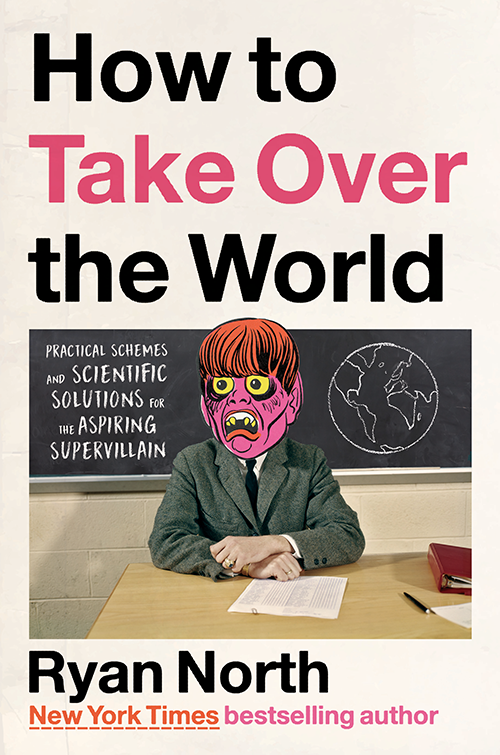If you are a supervillain with $55 billion to spend, Arts & Science alumnus Ryan North wants to help you take over the world — and he’ll be using his computer science degree to do it.
His new book, How to Take Over the World, is a not-to-be-taken-literally guide to world domination. With science to back him up, North walks readers through a series of outlandish, villainous schemes — and the book really does have everything.
Secret lairs in the sky? Check.
Tips on destroying the internet to save the world? You bet.
Immortality and time travel? Probably not possible, but North explores them anyway.
Humour and an entertaining read? Absolutely.
“I wanted the book to do what it says on the cover, so all the science is true. I’m not cheating with comic book science,” says North, who earned his master of science in computational linguistics — a discipline focused on understanding language from a computational standpoint — from the University of Toronto in 2005. “I’ve put this fictional candy coating around a non-fiction nougat core, and suddenly there’s a reason to care about learning about science.”
North is a prolific writer whose creative output spans decades, genres and formats. His recent work includes How to Invent Everything, a guide for readers who find themselves stuck in the past with an unfixable time machine — again, with science to support the narrative. He wrote the graphic novel adaptation of Kurt Vonnegut's Slaughterhouse-Five, and has long written comics, including his own Dinosaur Comics, the Unbeatable Squirrel Girl series for Marvel and Jughead for Archie Comics. He's a multiple New York Times bestselling author who has received too many awards to mention, including for his writing on the Adventure Time comic book series, Romeo and/or Juliet, and others.

In How to Take Over the World, he revisits a formula he developed for How to Invent Everything: take a quirky, fictional premise and back it up with science, research and tremendous fact-checking, all skills he learned at U of T. In fact, he gives a shout-out early in the book for U of T teaching him to be “really good at reading research papers,” a skill he couldn’t have written the book without.
(His U of T experience found its way into earlier books too. Sleuths who dig into the geographical coordinates of where time travel was invented in How to Invent Everything will realize it is U of T’s Sandford Fleming Building. In one of the Squirrel Girl comics, a data scientist has one of North’s old class assignments up on her open laptop screen.)
The straightest line between North’s computer science degree and the book may be found in Chapter 7, Destroying the Internet to Save us All. Here, he dives into methods of computer hacking, with descriptions of how compilers function. (Compilers translate computer code, designed by humans to be easily read, into machine language that is very difficult for humans to read). He includes a digression into an afternoon he lost in university after accidentally typing a colon instead of a semicolon — and the drawbacks of employing computer voting, all concepts he first encountered at U of T.
“The idea that there are limits to computers has always stayed with me, because you have to trust their output at a certain level,” he says, recalling a U of T lecture based on Ken Thompson’s paper Reflections on Trusting Trust, which demonstrated how even perfectly written code could be undermined, undetectably, by a compromised compiler. “That's 100 per cent spinning out of a lecture at U of T.”
Suzanne Stevenson, a professor in the Department of Computer Science and North’s thesis advisor while at U of T, says North’s studies would have helped his writing by giving him a strong knowledge of computer science, but also would have emphasized critical thinking, questioning assumptions, independence of thought and creativity.
“I personally think there's a lot in common between artistic creativity and creativity in the research process,” Stevenson says. “In addition to requiring deep insight and good intuition, excellence in research requires a freedom of thought or thinking outside the box — seeing things others haven't seen and making new connections — as well as having the belief in yourself to follow your own path. Ryan, of course, excels at all of these — his books and comics continually make funny or ironic connections between things, and he had the vision and self-belief to follow his dream of pursuing his art and writing.”

She points to Dinosaur Comics as having the kind of logic and creativity needed in computer science.
“There's this fixed structure with its own internal logic, but there's potentially infinite variety to the comics,” she says. “Part of the reason they're so funny is that they follow the same structure, and you have an expectation for the characters within that — Ryan deftly manipulates when those expectations are met and when they aren't.”
Despite the tremendous research it took to write How to Take Over the World — including chatting with researchers about their as-yet unpublished papers and visits with lawyers — North maintains the book is ultimately a work of fiction. What, then, should readers take away from the book?
“I think the core of the book is very collaborative and humanist and about solving problems, and not actually about being a totalitarian dictator,” North says. “I walk a bit of a line there, but it’s just for fun.”


